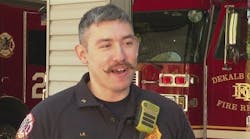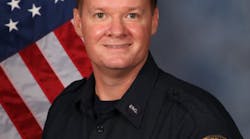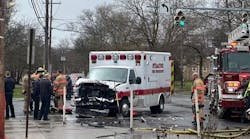We thank Contributing Editors William Goldfeder and Mark McLees for helping compile these reports. We again invite readers to share their experiences. You may send them to Chief Goldfeder at [email protected].
"Biggest Decision Of My Life"
Three volunteer fire companies, along with several emergency medical units, were dispatched at 3 A.M. as a part of a first alarm for an apartment building fire with numerous people trapped. The building was a three-story, brick frame structure with 18 apartments. The floors were served by an open stairway at the front of the building and a closed stairway in the rear. A long hall on each floor that split the apartments from side to side connected both stairways. The first floor was half set into the ground at all sides.
I responded from our station as the captain on the first due ladder truck. I had a crew of five firefighters, including the driver and myself. As we responded, chief officers on-scene advised that several people were trapped and more were jumping from upper-story windows.
Our apparatus was the first to arrive on scene and I observed heavy fire conditions involving the entire front stairway. We placed our apparatus in front of the building to reach the third floor. Several police officers helped my crew position ground ladders to trapped occupants on all sides of the building.
While one of the rescues was being conducted, an occupant jumped from a third-floor window and struck a firefighter halfway up a ground ladder. The firefighter was able to maintain his grip on the ladder, but the occupant fell to the ground.
Another rescue attempt was made at a third-floor window. The window was approximately 70% involved in fire. It had been reported that a person had been seen just minutes before at the window. Without the protection of a hoseline, firefighters from my crew and I attempted to gain entry into this window. We were unable to do so and had to back out.
While my crew was making a third rescue from a window, the assistant chief of the first-due fire company advised me that an invalid was trapped in a second-floor apartment. I accounted for my crew and we entered the rear stairway.
At the second-floor landing we located the first-in engine crew. They had pulled a 13/4-inch handline to the landing and were attacking the fire in the second floor hallway. I observed heavy smoke conditions from the third floor above us and moderate fire conditions in the second-floor hallway. I advised these two firefighters of our orders and had both crews enter the hallway. One of the firefighters from my crew (a ladder company) took over as the nozzleman. The two others each partnered with an engine company firefighter. The pairs began primary searches on either side of the hallway as I pulled more hose into the hall and the nozzleman moved forward. After the first two apartments were searched, all of us moved down the hall to the next set of apartments.
While crews were searching in these apartments, I saw the ceiling behind us collapse into the hallway and onto the hoseline. I made an attempt to call the incident commander to notify him of our position and of the collapse, but he did not immediately reply. As crews came out of the second set of apartments, I attempted to call again, but there was no answer. After reviewing the audiotape several other units and chiefs are heard discussing exposure problems, electric problems, notification for fire marshals and the Red Cross - all while my crew is searching for reported people trapped on the same channel.
Assuming that the chiefs could not hear me, I removed my face-mounted SCBA regulator from my facemask and attempted to call again. On the audiotape these calls are heard, but not answered. While making this call, I fell into the floor. My legs were dangling into the first floor - I was kept from falling through because my air pack was wedged between the floor joists. It was later reported to me that the first-floor hallway was involved in fire. I quickly scrambled to locate my loose regulator. Once I had the regulator back in place, I yelled for everyone to bail out of the building.
As the crews returned from searching the last set of apartments, they too fell into the floor. I could feel that firefighters were next to me in the floor. I heard a crash and the firefighter to my left slumped over onto me. Another firefighter later reported that a piece of wood had fallen and struck this firefighter on the head. I called again for the incident commander, this time screaming into the radio.
Several seconds went by and I could not make physical contact with any other firefighters. I did not know what had happened to my crew. Suddenly, the heat started to build up. It became unbearable. I leaned forward as much as possible and was able to open the nozzle above my head. I now had to make the biggest decision of my life. Either I had to stay and try to make sure my crew was getting outside or go out the way I came in. Without being able to make contact, either verbally or physically with any other firefighters, I decided that I had to get outside to get help and regroup, then I would be able to help them.
Every decision I make on the fireground, everything I teach to other firefighters reminds me of this moment. I left my crew! To this day I do not remember how I was able to get out of the floor, I just know that I did and I started following the hoseline out. Then I reached the area that had collapsed behind us. It was at this point that I started thinking about what was going on. Everything else I had done was from my training. Making the ladder rescues, accounting for my crew, assessing fire conditions, attempting to communicate, advising everyone to get out, reaching for the nozzle, and knowing that I had to leave to stay alive was all training.
Now I realized that I had a real need to get outside. I remembered that I was in a hallway and continued to proceed straight ahead. After moving several feet, I reached the rear stairway and made my way out of the building. A moment later, I was able to reach the incident commander by radio and advise him of the interior conditions and the unknown status of my crew. He reported that crewmembers had exited the front of the building. They exited over a roof ladder that had been placed over the burnt-out stairway in the front of the building. Some others left via windows from apartments on the second floor. The firefighter who was unconscious was carried out and had regained consciousness when they reached the exterior.
Crews in the front of the building were amazed that no one had advised them of our crew's position. No one came to their aid, none of my crew was ever checked by emergency medical services. Firefighters in the front of the building had made several attempts to gain access through the stairway without success. After my crew had exited they placed a 21/2-inch line into the stairway without knowing that I was still in that hallway! This was when the heat came down on me.
I have reviewed this incident in my mind thousands of times. For two years after this incident, I stayed away from the interior of buildings. Not until I was training in a flashover simulator was I able to really get back my confidence.
Since this fire, several changes have been made with the way our company operates. We have rapid intervention teams. We have rehab sectors. We have improved our incident command system and have more training. Most important, we now teach firefighters to transmit messages without waiting for a reply. I had been trained to call first, get a response and then continue with my message. Even though chiefs sometimes answered me, they never knew the gravity of the situation until it was too late. Some units even continued to transmit while the fire radio was attempting to clear the air so I could report the interior conditions and the unknown status of my crew.
I feel that if I had just transmitted our location and that we were in trouble several times, outside crews would have received it and could have responded to our needs. Our department now teaches firefighters to use "Mayday."
Lessons learned synopsis:
- Command must maintain a strong presence.
- ICS is not an option.
- When the crews are inside, they MUST have a clear radio channel. When this captain was calling for help, the radio channel was "busy" with calls that could have been made on a cell phone.
- Trained and skilled rapid intervention teams are not an option.
- Written and practiced "Mayday" procedures are essential for your safety.
- Radio marking/timing by the dispatcher maintains incident perspective.
- "Saving ourselves" training is critical.
- Coordinate staffing and staging.
- Train your firefighters that, when they are in trouble, FORGET radio procedures such as "this unit calling that unit" … get on the air, say what you need, what and where in plain English and say it often. Don't wait for courteous acknowledgements when you are in trouble.
- Our dispatchers did EXCELLENT work. They heard the screams for help and "took over" the radio when no one else answered. Our dispatchers have fire training and knew what to do - do yours? Do your dispatchers monitor all fireground operations as an "extra set of ears"?





